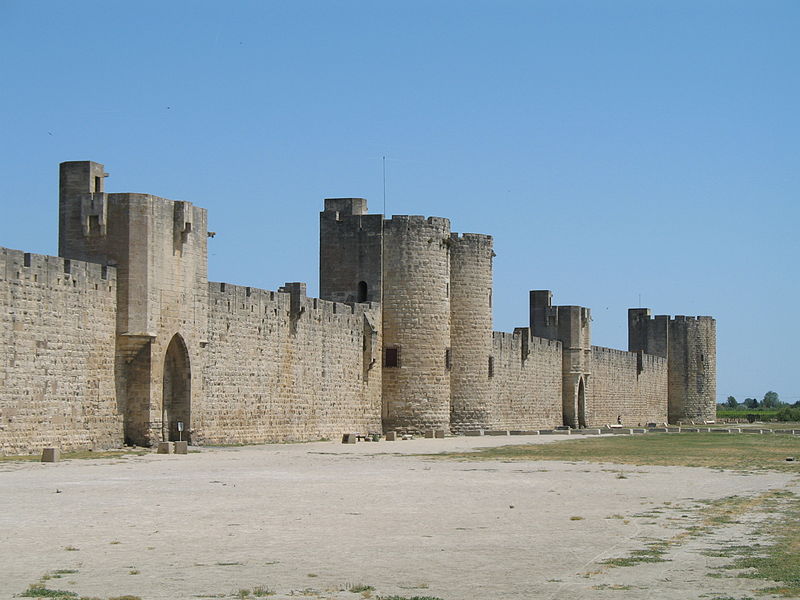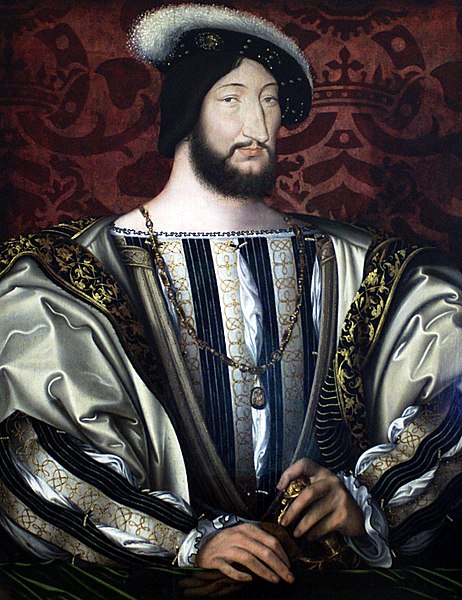 |
| Catherine de' Medici |
Contemplating Divorce
The political
benefits of Henri’s marriage to Catherine had been invalidated by the death of
her uncle the pope; there was nothing to be gained from an alliance with the
Medicis without the power of the papacy behind them. The Duchesse d’Étampes now put her weight behind a
campaign calling for Catherine to be repudiated, hoping that a new bride for
the Dauphin would destabilise Diane de Poitiers, a woman she considered her
enemy. The Guise family promoted one of their own as a replacement Dauphine,
Louise de Guise[i],
sister of Henri’s friend François.
The Guise
family under the tutelage of Duke Claude and his brother the cardinal, who were
to reach the zenith of their power in the reigns of Henri’s children, were
already flexing their muscles; François de Guise’s sister Mary[ii] was married to the King of Scotland. To further embroil Henri in their
coils, above and beyond the call of mere
friendship, would considerably add to their power base.
 |
| Marguerite de Navarre |
In her
plight Catherine had the support of the king’s sister Marguerite de Navarre as she tried to dance a line between
her father-in-law’s favourite and her husband’s mistress whose rivalry
increased as François began visibly ailing[iii].
Catherine threw herself on the kings’ mercy, sobbing at his feet. She agreed to
the divorce, only begging that she be allowed to serve her successor.
François
gave his daughter-in-law a reprieve she desperately needed to avoid being sent
back in disgrace to Italy;
‘My child, it is God’s will
that you should be my daughter and the wife of the Dauphin. So be it.’[iv]
And, reading
between the lines, Catherine threw herself in a desperate attempt to become
pregnant. She was given revolting poultices to wear and forced to drink mare’s
urine. She finally became pregnant in the summer of 1543; the child, named after his grandfather, was
born on 19th January 1544.
The Fall of Montmorency
 |
| Aigues-Mortes |
In 1538
Montmorency was made Constable of France[v]. But after 1538 French foreign
policy did an abrupt reversal; François was persuaded by Pope Paul III[vi] to ally himself with Charles V[vii].
Although both men initially refused to meet face to face they finally met at Aigues Mortes on 14th July 1538. Paul was eager to promote a
crusade against the Turks. François’ hopes of Milan were dashed when Charles, in
October 1540, invested his son Philip as duke.
It was this
action which was to precipitate the fall of Montmorency who had supported the
alliance between Charles and François, hoping that Charles V would hand over
Milan.
The Duchesse
d’Étampes aided and
abetted Montmorency’s enemies. Montmorency, who retired to his chateau at
Écouen, was refused permission to return to court. He was not stripped of his
titles and posts; he was just ignored and others were called upon to fill the
roles Montmorency had undertaken in the past.
 |
| Maria of Spain |
The murder
of two French diplomats in Piedmont seemed to François to presage another break
out of war between the two countries and he declared war on 12th
July 1542, organising an invasion of Luxembourg, sending
Prince Charles with one army to the north and the Dauphin south with an army to
Perpignan. François
failed to recall his most able general from exile. François and his ally Barbarossa[x] took Nice and the
Turks set up shop in Toulon, at the invitation
of the French much to the horror of Christian Europe[xi].
In 1544 both the imperial army and the English invaded France; the
English walking off with Boulogne and Charles V besieging Saint-Dizier. The peace of
Crépy found François agreeing to marry his son Charles to the emperor’s
daughter Maria[xii] or his
niece Anna[xiii][xiv].
The treaty also raised the distinct possibility of France being split
between Henri and Charles, with Charles’ inheritance being swallowed up into
the Holy Roman Empire. Henri did make a formal protest, but was ignored. Peace
talks between the English and French foundered on Henry VIII’s refusal to give
up Boulogne and demand that the French stopped supporting their allies in
Scotland.
Inter Sibling Rivalry
.jpg/469px-Charles_II%2C_duc_d'Orl%C3%A9ans_(1522-1545).jpg) |
| Charles d'Orleans |
The last
decade of François’ reign was embittered by the rivalry between the Dauphin and
his brother. Always François’ favourite, the rift between the two brothers was
deepened after Montmorency’s fall; Henri stayed true to his friend, while
Charles became a follower of the Duchesse d’Étampes. Parties formed around the
two princes with Montmorency’s friends forming Henri’s followers, while the
great man’s enemies supported Charles.
The rivalry deepened during the war of 1542 as Henri was forced to
retreat from Perpignan while Charles conquered Luxembourg, winning military and
popular acclaim. The peace of Crépy had been designed to advance Charles’ and
the Holy Roman Emperor’s interests at the expense of those of Henri and France[xv]. The enmity between the
two brothers was only stopped by death when Charles died of the plague, then
rampant in Paris, in September 1545.
Always
impetuous Charles rushed into a room, where someone had died of the plague, and
cut up the bed linen and mattress, showering the room with feathers, claiming
that his royal blood would not allow him to succumb;
‘Never yet has a son of
France died of the plague.’[xvi]
He died a
week later. Henri had tried to visit his brother but was barred from the
sickroom. Henri and Charles had barely spoken since the peace of Crépy which
was now made meaningless by Charles’ death.
Learning the Art of Ruling
 |
| Francois I |
François’
dislike of his heir led to Henri being excluded from royal council meetings; he
grew up in ignorance of how to rule the country he was to inherit. Charles’
death was to change that, along with François who became very melancholic. Now
François started having Henri taught the art of statecraft.
One night
when drunk and believing himself alone with his cronies it was reported that
Henri commented;
‘That when he was King, he
should name such and such persons marshalls or grand-masters….[adding] that he
should recall the Constable.’[xvii]
He was
overheard by the king’s fool who rushed off to inform his master who was most
wrathful at Henri’s impudence; throwing furniture, cutlery and other objects around
his rooms. Henri and his friend took off before François could catch them;
Henri kept away from court for over a month while his father’s temper cooled.
The Dauphin
was concerned by the influence the Duchesse d’Étampes had on affairs of state. She and
her supporters could read the writing on the wall as well as anyone and were
making desperate attempts to shore up their positions.
In the
autumn of 1544 François banished Diane de Poitiers from court because his son
had the temerity to replace one of the Duchesse d’Étampes favourites when Henri was
campaigning in Picardy. She was forbidden to return until
the following year. In the meantime Henri forbad his wife to talk to the
duchess. François showed his daughter-in-law, pregnant with her second child,
especial favour that Christmas. He showered her with gifts including a diamond
worth 10,000 éçus[xviii].
The baby Elisabeth was born in April 1545.
On 7th
June 1546 peace was agreed with England; at the Treaty of Ardres, the English would return Boulogne
after eight years, for the sum of 2 million éçus[xix].
Following the signing of the treaty Henri and Catherine went on a royal
progress inspecting the border defences of eastern France.
Bibliography
Martyrs and
Murderers – Stuart Carroll, Oxford University Press 2009
Catherine de
Medici – Leonie Frieda, a Phoenix Paperback 2003
Charles V –
Harald Kleinschmidt, Sutton Publishing 2004
French
Renaissance Monarchy – RJ Knecht, Longman Group 1996
The Rise and
Fall of Renaissance France – RJ Knecht, Fontana Press 1996
Catherine
de’ Medici – RJ Knecht, Pearson Education Ltd 1998
A History of
France – David Potter, The MacMillan Press 1995
Prince of
the Renaissance – Desmond Seward, MacMillan Publishing 1973
Emperor
Charles V – James D Tracey, Cambridge University Press 2010
Henri II – H
Noel Williams, Methuen and Co 1910 (reprint 2016)
www.wikipedia.en
[iii]
The duchesse made much play of the eight years difference between her and the
older Diane. While Diane slept with no other man bar Henri and made much of her
exclusiveness, Anne was renowned for sleeping around; François was aware of the
situation but pretended otherwise
[iv]
Catherine de Medici - Frieda
[v]
The job came with a salary of 24,000 livres per annum. In 2015 the relative: historic standard of
living
value of that income or wealth is £13,950,000.00 labour earnings of that income or wealth is
£145,000,000.00 economic status value of that income or wealth is £512,000,000.00 economic power value of that income or
wealth is £6,645,000,000.00 www.measuringworth.com
[vii]
François hoped thereby to finally gain Milan
[viii]
Roughly translated as I have lost the [king’s] favour and I bid him farewell
[ix]
Henri II - Williams
[xi]
Even François was relieved when they left in May 1544
[xiv]
The treaty was to founder with Charles’ death in 1545
[xv]
He was to receive the Low
Countries if he married Maria or be made Duke of Milan if he married Anna
along with a number of strategic duchies in France; Orléans, Châtelleraut, Bourbon and Angoulême
[xvi]
Catherine de Medici - Frieda
[xvii]
Ibid
[xviii]
In 2015 the relative: historic standard of
living
value of that income or wealth is £4,858,000.00 labour earnings of that income or wealth is
£54,720,000.00 economic status value of that income or wealth is £160,900,000.00 economic power value of that income or
wealth is £1,979,000,000.00 www.measuringworth.com
[xix]
In 2015 the relative: historic standard of
living
value of that income or wealth is £1,112,000,000.00 labour earnings of that income or wealth is
£10,900,000,000.00 economic status value of that income or wealth is £38,820,000,000.00 economic power value of that income or
wealth is £485,500,000,000.00 www.measuringworth.com
No comments:
Post a Comment
Note: only a member of this blog may post a comment.